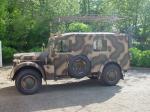Horch 901 Funkwagen Kfz 17 avec Radio FU 11 SE 100
English Translation
Photos tirées de ce site Pics from with website
Historique Voir ICI
History Click HERE
Traduction de l article paru sur ce site Traduction of this article
Le Kfz 17 FUNKWAGEN est le plus petit FUNKWAGEN construit pour l'armée allemande sur la base d'un châssis «Mittlere Einheits Pkw" Horch Horch 901 ou 901 40 Type châssis avec moteurs V8 Horch.
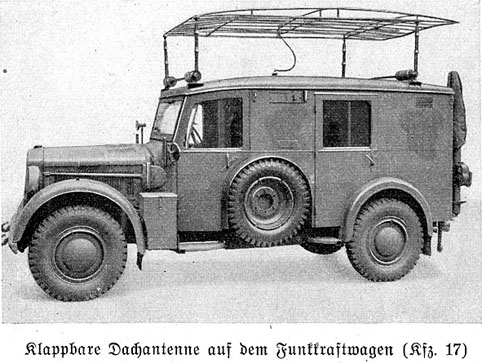 |
 |
Il existe un certain nombres de version du Funkawagen Kfz 17 avec antennes pour ondes longues, version de central téléphonique et une version Kfz 17/1 en configuration d'antenne VHF.
La version "Type 40" du châssis Horch 901 était une version légèrement simplifiée introduit en 1940. Les modèles précédents avant guerre avaient des "Stutzachse" ou roues de secours, un de chaque côté, agricole donc mobile afin de faciliter les passages difficiles. Pour les version,s produite apres 1940 l'option "Stutzachse" a été remplacé par une seule roue de secours fixée sur le côté gauche.
Sur la 17 Kfz, les autres changements comprennent le remplacement du toit metallique par un toit en lamelles de bois et un raccord d'antenne de toit mobile
Le véhicule dispose de deux antennes. L'antenne large de toit peut être utilisée lorsque le véhicule est en mouvement. Il repose sur quatre isolateurs et il es fixé sur deux axes à ressort. De cette manière, l'antenne peut être tirée vers le bas afin de réduire la hauteur hors tout du véhicule pendant le transport. L'antenne de toit a une grande puissance avec une portée de 40-60 kms en morse et 10-20 km en utilisant la radio.
On trouve aussi une deuxième antenne télescopique KM8 "Kurbelmast". En statique une antenne «Sternantenne» peut etre placée sur le dessus de la Kurbelmast
 |
lAvec le poste W.S. 100 on utilise une "Sternantenne C" qui est semblable à la "Sternantenna A", . le mat peut être levé jusqu' à 2,5 mètres afin d'augmenter la portée. L'antenne possède un fil (Antennezufuehrung) de 7,5 mètre Un petit bras isolant empêche le fil de l'antenne de frapper le côté de l'antenne du véhicule et le toit. Pour augmenter la portée des cables peuvent être reliés aux ailes arrière du véhicule.ainsi en stationnaire la portée est de 160-200 km en utilisant morse et environ 60 km en utilisant la voix.
Le vehicule possède une installation radio complete ce qui l'oblige à avoir des espaces de rangement, dont le principal est situé à l'arrière du véhicule:
 |
 |
Ce compartiment arrière contient contient des lampes de rechange Fu51, un générateur de GG600 pour recharger les batteries avec un bidon d'essence et d'un bidon d'huile. Il contient des sardines et du materiels afin de mettre en place De plus il contient les paquetages des hommes(sacs à dos Tornister et des tentes )
La boite de la batterie Torn.Eb peut également être stockée dans un compartiment spécial. Le cadre de ce compartiment est amovible
L'intérieur du Kfz 17 est divisé en deux compartiments. Le compartiment avant contient les sièges du conducteur et du commandant de la Funktrupp
Le tableau de bord est d'un modèle standard pour les Kfz 15/17. Les commandes sont à peu près comme dans toute 4x4, la boîte de vitesses 4 vitesses non synchronisée. Le levier entre les sièges permet de mettre en oeuvre le crabotage . Cest une voiture assez bonne en tout terrain mais lourde ( 3,5 tonnes à pleine charge).
La borne électrique CEE pour le Torn.Eb est placée sur le mur de gauche à côté de conducteur Si nécessaire, une unité suplementaire Eua "Umformer" peut être placée entre les sièges.
 |
 |
Le commandant de la Funktrupp est assis à droite La portière de droite contient une table pliante sur laquelle la machine Enigma peut être placée . La cloison de droite contient également le "Schaltkasten (Fu) b" boîte de connexion pour l'installation de 12 V qui alimente les radios.
Le plafond contient un certain nombre de compartiments pour stocker des documents, ( certains peuvent être verrouillés.)
La voiture est équipée de deux batteries, la batterie de voiture standard, plus une batterie spéciale sous la table de la radio. Ces deux batteries sont placées en parallèle En position statique un générateur GG600 est utilisé à terre pour fournir l'énergie. Une boîte à fusibles spéciale relie les deux batteries avec le boîtier de connexion 12 V. Le cas échéant, l'installation radioélectrique ainsi que la batterie de la radio peuvent être debranchées de manière à pouvoir être mis en place à distance du véhicule.
Le compartiment arrière contient une grande table pivotante pour le travail des radios:Elle occupe toute la largeur du véhicule. Lefond est équipé de «rails» auxquelles les ceintures "Spannband» des radios peuvent être fixés. Un support spécial pour la clé morse est attaché à la section articulée.
Sur chaque paroi latérale dessus de la table possède deux prises 12 V «Bosch» et un connecteur "Gegengewicht» pour l'émetteur et le récepteur. Les prises 12 V sont utilisés pour l'alimentation des CEE et pour les feux montés sur les radios.
La partie gauche contient en outre un connecteur pour un téléphone de campagne et de l'antenne externe. Sur le côté droit on trouve deux trous, l'un pour le câble de transfert de générateur pour le GG600, l'autre pour une antenne externe. Les connecteurs et les trous possèdent des petites portes coulissantes sur la carroserie extérieure du véhicule.
Sous la table se trouve un certain nombre de compartiments de stockage. Le côté gauche contient «Kunstantenne" pour les 100 WS et des piles de rechange pour le Torn.E.b. A droite on trouve l'alimentation de l'émetteur, Le compartiment du milieu verrouillable contient la machine Enigma.
Un sac fixé à la porte arrière droite peut être utilisé pour stocker la clé de morse et le microphone pour l'émetteur.
Les deux radios «Funkers" sont assis sur les sièges spéciaux avec coussins qui peuvent être enlevés Des tiroirs dont placés sous les sièges . ils peuvent servir de stockage tels que la paperasserie et instruments d'écriture ainsi que kit pour mesurer et réparer les radios .Des isolateurs d'antenne ou autre objets peuvent être stockés ici. Le tout peut être facilement enlevé pour donner accès à la trappe d'entretien du milieu, qui donne accès au différentiel arrière et au réservoir de carburant .
 |
Une boîte "ZBG N 12" est placé entre les sièges, il contient trois lampes spéciales qui s'adapte sur les radios de sorte que les ensembles peuvent être exploités dans l'obscurité.
 |
Aussi le véhicule est équipé de rideaux occultants devant toutes les fenêtres ainsi que entre les deux compartiments de l'équipage.On trouve aussi les supports pour deux fusils qui peuvent aussi être placées entre les sièges contre la paroi arrière (deux autres fusils peuvent être stockés dans le compartiment avant.
L'équipement radio du Kfz 17 est assez variable( FU 11 SE 100 avec Torn.Eb et 100 WS )
Les Torn.E.b et 100 W.S. sont placés sur silentblocs spéciaux sont fixés au câble utilisant des ceintures spéciales »Spannband". De cette façon, l'ensemble est solidement fixé au véhicule ce qui est appréciable surtout en tout terrain
L'alimentation de l'U100 est fixée avec des supports spéciaux. Des trous dans la table permettent aux différents câbles de passer. Les bornes "Gegengewicht" sur l'émetteur et le récepteur sont reliées aux bornes sur les flancs. Le câble de l'antenne de l'émetteur est connecté soit à l'antenne de toit ou à l'antenne externe.
Une antenne en cuivre plomb est montée sur la partie supérieure de la paroi de séparation entre les deux compartiments. Il se connecte au connecteur d'antenne externe (à gauche du véhicule.)
Un fil de cuivre plus court se connecte à un isolateur passant par le toit de liaison de l'antenne de toit. Le conducteur d'antenne est fixé avec un écrou à oreilles . La A "Funkeruhr ou station horloge est placée au centre de la paroi de séparation supérieure.
La "tablette" à l'arriere des sièges arrière peut être utilisée pour stocker l'équipement de l'équipage. Quatre crochets de vêtements servent à accrocher des tuniques ou des casques. Sur la gauche de la tablette se trouve un support pour téléphone de campagne de FF33.
Il existe actuellement 7 à 10 survivants Kfz 17.
The Kfz 17 Funkwagen is the smallest fully enclosed Funkwagen built for the German Army. It was built on the chassis of the "Mittlere Einheits Pkw"; most surviving examples seem to be Horch 901 or Horch 901 Type 40 chassis with Horch V8 engines.
A nunber of variations of this body type existed, the Kfz 17 radio car version with antennas for Long Wave radios, a telephone exchange version and the Kfz 17/1 with a VHF antenna configuration. My story is about a "Type 40" Kfz 17 long wave radio version.
The "Type 40" version of the Horch 901 chassis was a slightly simplified version to speed up production, introduced in 1940. Previous models had a so called "Stutzachse" where the spare wheels, one on each side, were mounted on rotating hubs. The idea being that if the vehicle "bellied out" in the terrain, it would roll on it's spare wheels and would not get stuck. In practice however this caused the vehicle to loose traction so in the "Type 40" the "Stutzachse" was replaced by a single fixed spare wheel on the left side. For the Kfz 17, other changes included the replacement of the upper body work from wooden slats to pertinax sheeting and the fitting of a more effective folding roof antenna.
The vehicle has two antennas fitted. The large roof antenna can be used while the vehicle is moving. It sits on four insulators which can turn on two spring loaded axis. In this way the antenna can be pulled down to reduce the overall height of the vehicle during transport. Togehter with the chassis, the roof antenna forms a large capacity so that a relatively large antenna current can be produced in the short leads connecting the transmitter to the chassis and antenna. Using a 100 W.S., the roof antenna would have a range of 40-60 Km using morse code, 10-20 Km using voice.
Second antenna is the telescopic KM8 "Kurbelmast". In static situations a "Sternantenne" would be placed on top of the Kurbelmast and the mast would be extended:
With the 100 W.S. the "Sternantenne C" would be used. The "C" is similar to the "Sternantenna A", but the antenna rods can be extended to 2,5 meters to create a larger capactive area. The actual antenna is a 7,5 meter long "Antennezufuehrung" wire between the Sternantenna and the fixed antenna connnection on the left side of the vehicle. A small insulator arm prevents the antenna wire from hitting the side of the vehicle and roof antenna. To extend the range further, counterpoise wires would be connected the the rear wings of the vehicle. In stationairy configuration the range of the 100 W.S. could be extended to 160-200 Km using morse and about 60 Km using voice.
The complete radio installations have a lot of "Zubehoer" and the vehicle is equiped with a variety of storage compartments, the main one in the back of the vehicle:
The rear compartment contains the Fu51 lamp set, a GG600 generator to recharge the batteries with a jerrycan of petrol and a can of oil. It contains herrings, earthpicks etc to build an external antenna. Further more is contains the "Tornister" backpacks of the crew and tent materials. When not in use the battery box for the Torn.E.b can also be stored in a special compartment. The framework in the storage compartment is removable so that access can be gained to the rear maintenance hatch above the rear fuel tank in the chassis.
The interior of the Kfz 17 is split in two compartments. The front compartment contains the seats for the driver and commander of the Funktrupp:
The dashboard is pretty much standard Kfz 15/17. The controls are pretty much as in any 4x4, the unsynchronised 4 speed gearbox taking some getting used to. The lever between the seats engages the 4 wheel drive and low gearing. The car has automatic self locking differentials so it should be pretty good in rough stuff although at 3,5 ton fully loaded it has some weight to haul around.
The E.W.c vibrating power supply for the Torn.E.b is placed on the left wall next to driver. If required, an additional E.U.a "Umformer" can be placed between the seats.
The commander of the Funktrupp would sit in the co-driver seat. The right hand door contains a collapsible table on which the Enigma machine would be placed for en/de-crypting the messages. the right hand wall also contains the "Schaltkasten (Fu) b" connection box for the 12 V installation which supplies the radios.
The ceiling contains a number of compartments for storing documents, some of which can be locked.
The car is fitted with two batteries, the standard car battery plus a special battery on the floor under the radio table. These two batteries are placed in parallel and charged via a heavy generator on the engine. In stationairy position the GG600 Generator would be placed next to the vehicle to keep the batteries under charge.
A special fusebox connects the two batteries with the 12 V connection box. If need be, the radio installation plus the radio battery can be removed so that it can be set up away from the vehicle.
The rear comportment contains a large table for mounting the radio installation and accessories:
The table runs the comple width of the vehicle. The top of the table is fitted with "rails" to which the "Spannband" belts of the radios can be fixed. A hinged portion of the table can be used as a writing surface, or can be folded down when not in use. A special bracket for the morse key is attached to the hinged section.
On each sidewall above the table are two 12 V "Bosch" sockets and a "Gegengewicht" connector for the Transmitter and the receiver. The 12 V sockets are used for the E.W.c power supply and for lights mounted on the radios.
The left hand side furthermore contains a connector for a field telephone and for the external antenna. On the right hand side has two holes, one for transferring the generator cable for the GG600, the other for an external antenna. The connectors and holes are covered by small sliding doors on the exterior of the vehicle.
Under the table are a number of storage compartements. On the left hand side for example contains the "Kunstantenne" for the 100 W.S. and spare batteries for the Torn.E.b. On the right is the power supply for the transmitter, in this case a U100. The middle lockable compartment contains the Enigma cyphering machine.
A bag fixed to the right rear door could be used to store the morse key and microphone for the transmitter.
The two "Funkers" sat on box type seats:
The seat cushions can be removed and special "drawers" placed under the seats can be accessed. The boxes contain more "Zubehoer" such as paperwork and writing utensils as well as kit to measure and repair the radios. Also loose bits such as antenna insulators etc are stored here. The complete seat frames can be easily removed to give access to the middle maintenance hatch, which gives access to the rear differential and middle fuel tank.
A "Zbg N 12" box is placed between the seats, this contains three special lamps to fit on the radios so that the sets can be operated in the dark. For this reason the vehicle would be fitted with blackout curtains in front of all windows as well as between the two crew compartments. Brackets to hold two rifles for the crew could also be placed between the seats against the back wall (a further two rifles could be stored in the front compartment, either side of the dashboard).
The Kfz 17 could be fitted with various radio installations, in this example the FU 11 SE 100 consisting of the Torn.E.b and 100 W.S.:
Both the Torn.E.b and 100 W.S. are placed on special shock mounts and are fixed to the cable using special "Spannband" belts. In this way the set is securely fixed to the vehicle which is espeically important when driving through uneven terrain. The U100 power supply is fixed with special brackets and bolts to the bottom part of the table. Holes in the table allow the various cables to be tucked away. The "Gegengewicht" terminals on the transmitter and receiver are connected to the terminals on the sidewalls. The Antenna cable of the transmitter is connected to either the roof antenna or to the external antenna.
A long copper antenna lead is mounted on the upper part of the dividing wall between the two compartments. It connects to the external antenna connector on the top left wall of the vehicle. A shorter copper lead connects to an insulator going through the roof connecting to the roof antenna. The antenna lead is fastened with a wingnut to either antenna. A "Funkeruhr" station clock is placed in a bracked in the middle of the top dividing wall.
The "parcel shelf" behind the rear seats can be used to store the crew's equipment. Four clothing hooks could be used to hang tunics or helmets. On the left of the parcel shelf is a bracket to hold a FF33 field telephone. A connection runs on the righthand wall to the telephone connection bracket next to the table.
Of the approximately 7 to 10 surviving Kfz 17's, "WH 473 938" is currently probably the most complete example in existance. The Norwegian army museum also has a reasonably complete running example. There are another 5 or so restoration projects in various stages of progress. Still "WH 473 938" needs a lot of detailing before it will be 100% complete and correct.
Voir Aussi Autre Photoscope See Also Other Walk Around
Stoewer R180S lichte Einheits-Pkw - lEpkw
Horch 901 Kfz 15 Lettonie
Horch 901 Funkwagen Kfz 17 -radio FU 11 SE 100
Horch KFZ.15 Horch Bastogne
Horch 901 KFz15 Mittelschwerer geländegängiger PKW Sinsheim
Horch 108 Typ 40 Sinsheim






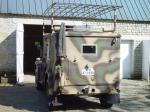
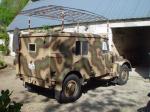
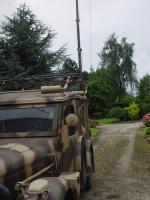
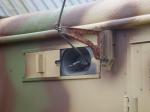
.jpg)
.jpg)
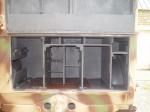
.jpg)
.jpg)
.jpg)
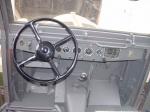
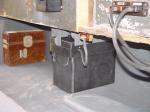
.jpg)
.jpg)
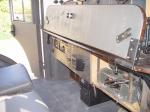
.jpg)
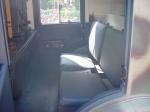
.jpg)
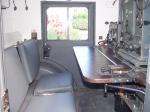
.jpg)
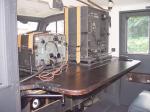
.jpg)
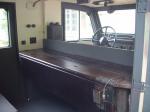
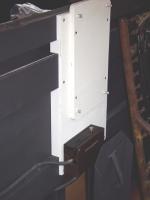
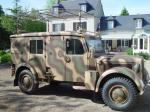
.jpg)
